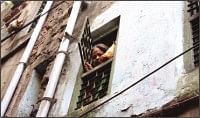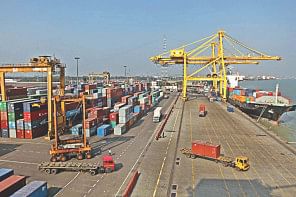Dhakaiyas drifting to new city

Dhakaiyas gradually moving to the new part of the city to live a life modern and free from dirt and congestion.Photo: Shafiq Alam
Azim Baksh, a 61-year-old resident of Gulshan, always feels nostalgic whenever he crosses Fulbaria, where starts the Old Dhaka established more than 400 years ago.
Born and brought up in Farashganj area, Baksh moved to the newer part of the city in 2000 leaving behind the legacy of his four generations of predecessors, many relatives, close neighbours and probably a few foes in Old Dhaka.
Like him, many residents of Old Dhaka who identify themselves as the true Dhakaiyas are gradually moving to newer parts of the city giving birth to a whole new social phenomenon, changing a community that lived in harmony for centuries.
“During my childhood there was no such concept of Old Dhaka. What we know as old town today was the modern Dhaka then,” said Baksh.
“As the city gradually began to grow a distinction appeared creating the concept of old and new. Fulbaria used to be the city's main railway station till mid 1960s and it was considered as the border line between the two parts of Dhaka,” Baksh said.
Baksh explained that the community of Dhakaiyas had a deep bond, which began to loosen up when reality brought many new faces to the old town.
“We were introduced with something that never existed in our area. Hooligans took shelter in our part of the town, muggers became active even during the daytime,” he said.
Alauddin Ali, a resident of Urdu Road, moved to Moghbazar area recently. His story is different. “As our family began to grow the house we inherited became narrower with more partitions between the rooms. We just had to move as there was no room,” he said.
“I also had to move from Old Dhaka for schooling of my children. Today every reputed educational institution is situated in the newer part of the city. The schools of old town where we studied lost their grandeur,” Ali said.
The younger generation is more inclined to move than the older generation. “My office is in Banani Chairmanbari. The sufferings, the traffic jam that we have to go through getting in and out of the old town became unbearable. The alleys became narrower every day,” said Abdus Shakur Munshi who moved to Nikunja from Lalbagh.
Dr Hafiza Khatun, professor of the Department of Geography and Environmental Science at Dhaka University in her book 'Dhakaiyas On the Move' published in 2003 discussed various aspects of the Old Dhaka dwellers' migration pattern.
“Intra-urban migration is a very normal phenomenon. It happens every day. Today's Dhaka was created by the Dhakaiyas, a community with deep social bond, individual way of living, exclusive dialect, heritage, food and rituals,” Prof Hafiza said.
“They lived together for a very long time. When they began to move away from their home it became a major social phenomenon,” she added.
Prof Hafiza makes an effort to identify the true Dhakaiyas. “Dhakaiyas are the earlier settlers of old town who owned property in the cadastral map (a map that records property) of 1912 published by the then municipality of Dhaka.”
Their identity is also associated with Banga Bhanga (the creation of two Bengals in 1905). Those who lived in Dhaka before that period are also considered the original Dhakaiyas. Many came after that but they moved to other parts out of necessity. Only the true Dhakaiyas remained in their ancestral homes, she added.
According to the professor, the oldest neighbourhood in Dhaka would be the places around Buriganga River originated according to the need of the businessmen. Then gradually the city began to spread horizontally.
Dr Hafiza mentioned Dhakaiyas have two communities among themselves - the Kutti and the Khushbash. “We consider all Dhakaiyas as Kutti. This is wrong. The Kuttis used to be the working class and the Khushbash or Shukhbash had close connection with the administration and belonged to a bit upscale segment,” she said.
She also noted that their dialect is also slightly different from one another. “The dialect of the Kuttis has more Bangla with a blend of Urdu while the dialect of others is more influenced by Urdu with a blend of Persian and Bangla.”
According to her research, the migration was there even before 1971 and it continued during post-independence period.
However, it became a major trend in the 1990s and it is still going on. “One important pattern we have to consider is that it is a trend of those who can afford to move. Others with less solvency tend to remain in their ancestral homes,” said Prof Hafiza.
Prof Hafiza mentioned economic factors as one of the main reasons behind the migration.
“Business moved to more modern and convenient part of the city as Old Dhaka did not appeal customers anymore. Property ownership to other part of the city also increased.”
She said, “There was a time Dhakaiyas used to marry among themselves. This tradition also changed. Marriage to other community is another major reason.”
The migration pattern however is prevalent among the Muslims. The Hindus living in old town tend to cling to their place of birth for many reasons.
Babul Das, a fourth generation jeweller in Tantibazar, said, “We simply cannot think of moving away from Tantibazar. This is my home. All my relatives are here. Every inch of this alley evokes memories of my predecessors.”
“Most importantly the temples are all in the old town. It will not be possible to perform Puja or other religious rites in the other part of the city like we do here,” he added.
“Besides, moving from here might mean losing our property as happened to many Hindus in many parts of Bangladesh,” Das said.
With migration the communal bond however is not entirely severed. Nostalgia brings every true Dhakaiyas back to the intricate alleys every now and then.
“The train line is no longer there in Fulbaria, yet the feeling of invisible border still exists. Every time I cross that line I have this special feeling that I am back to my home. As I enter the intricate alleys I feel very nostalgic,” said Baksh.
Baksh still performs Tarabi prayer during Ramadan and Eid prayer in the mosque of his old neighbourhood. Animal sacrifice during Eid-ul-Azha also takes place among his relatives in Farashganj. “I miss the cultural bond, the social programmes. At the mosque we meet old friends. This get together helps us cope with the new town,” he said.
Munshi on the other hand misses the deep fried delicacies of old town. “The scrumptious items that Chawkbazar still offers cannot be found anywhere else in the city. The taste is simply divine and cannot be compared with anything that the new town offers.”

 For all latest news, follow The Daily Star's Google News channel.
For all latest news, follow The Daily Star's Google News channel. 



Comments